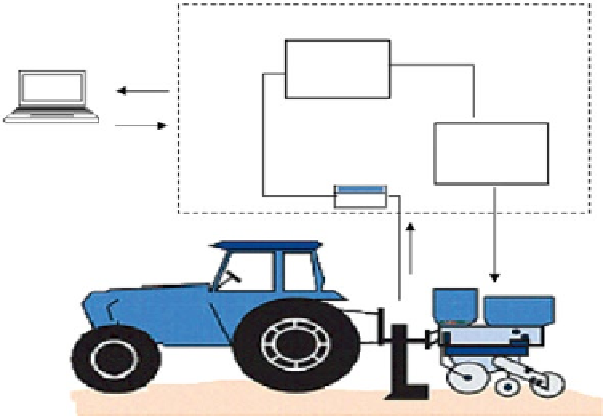Agriculture Reference
In-Depth Information
spectra-
processing
program
control of
P application
during sowing
sensing spectra
underneath sweep
Fig. 9.13
Scheme for site-specific on-the-go flat surface sensing and control of phosphorus appli-
cation during sowing (From Maleki et al.
2008a
, altered)
the reflectance that is received by the spectrometer and thus impairs the sensing
precision (Mouazen et al.
2009
).
Furthermore, the
time lag
that is inevitable between the spectral soil scanning
and the deposition of the fertilizer deserves attention. For accurate georeferenced
site-specific operation, this time lag must be compensated for by a defined distance
of the soil scanning device ahead of the fertilizer outlets. This time lag is gener-
ated by processes that successively take place, first the soil scanning, then the
spectra processing plus signal transportation and finally the reaction of the fertil-
izer applicator due to the site-specific adjustments by the electric actuator. Each
of these processes goes rather fast, but the total succession still takes between
1 and 2 s.
The offset distance in the direction of travel that is needed for the sensor position
ahead of the fertilizer outlets in order to compensate for this time lag depends on the
tractor speed. Maleki et al. (
2008b
) found that for each 1 km/h in tractor speed, an
offset for the sensor ahead of the fertilizer outlets of 0.5 m was required. This means
that the design as outlined in Fig.
9.13
would be adequate only for rather low speeds.
For a speed between 7 and 8 km/h it is recommended to install the sensor in front of
the tractor. In case this results in excess offset because then the overall time lag is
not sufficient to compensate for the distance to the front of the tractor, an
artificial,
additional time delay
in the signal transfer can easily correct the situation.
Time lags occur with all sensors that are used in on-the-go field operations.
However, as long as the problems can be solved by spatially arranging the machine
elements accordingly or by artificial time delays in the signal transfer - as shown
above - the precision in the application of agrochemicals still can be good.

